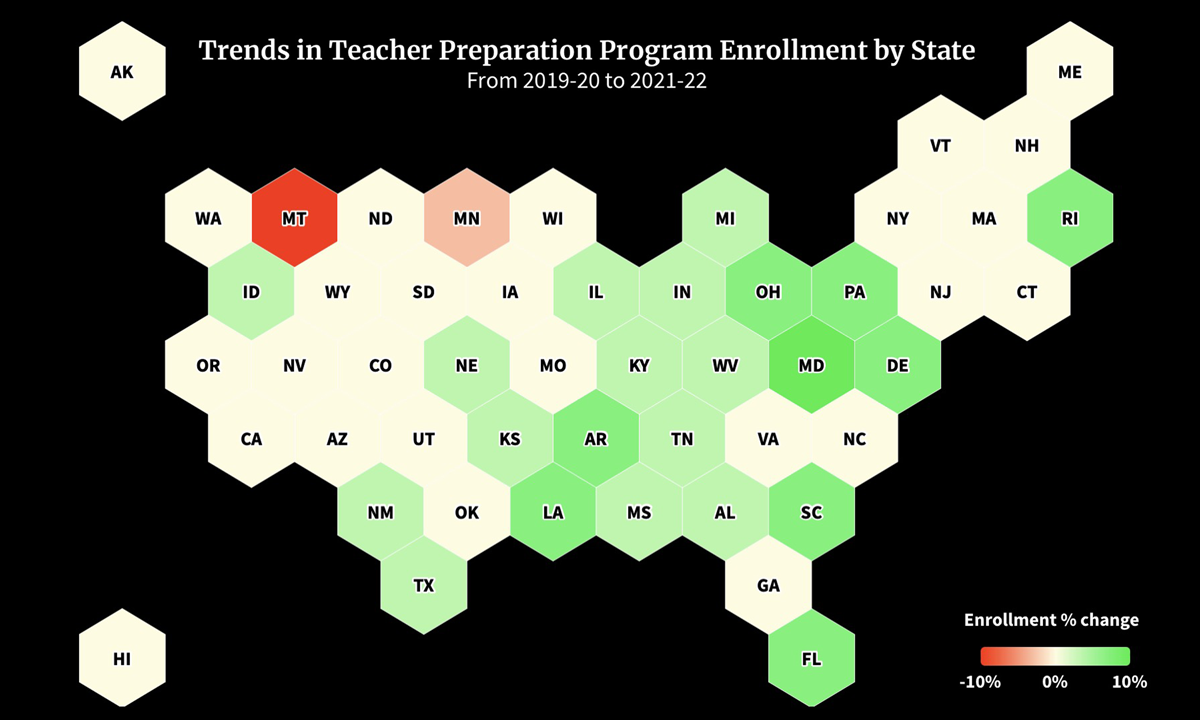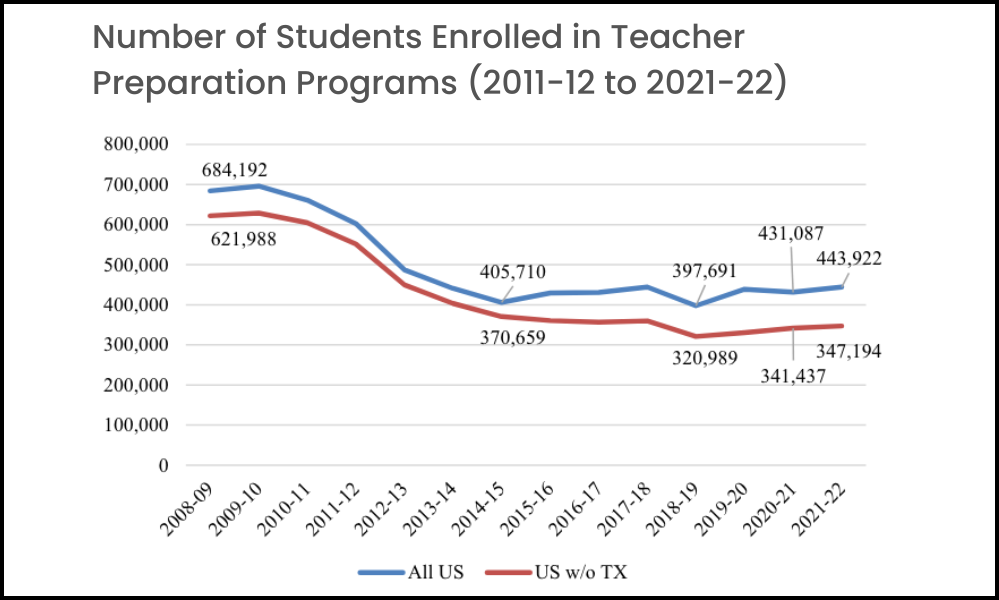Teacher Prep Programs See ‘Encouraging’ Growth, New Federal Data Reveal
During key pandemic years, teacher prep enrollment increased or stabilized in 40 states. Why it’s not enough to curb shortages.

Get stories like these delivered straight to your inbox. Sign up for The 74 Newsletter
It’s no secret that America’s teaching pool is a fraction of the size it once was 15 years ago, hard hit by the Great Recession and mostly shrinking since.
But new federal data has given researchers some cause for optimism, suggesting efforts to make teaching more financially viable with strategies such as paying student teachers have helped to move the needle.
From 2018 through 2022, enrollment in teacher preparation programs grew 12% nationally, or by about 46,231 more candidates, according to a March report on Title II data from Pennsylvania State’s Center for Evaluation and Education Policy Analysis.
Nine states lead the pack with notably higher bumps in teacher prep programs in recent years: Arkansas, Delaware, Florida, Ohio, Louisiana, Pennsylvania, Ohio, Rhode Island, South Carolina and, with the highest average growth, Maryland.
The modest upswing, seen both in enrollment and completion rates, during some of the most strained years in American education, has surprised experts.
“It was encouraging to see … at the height of the pandemic, it certainly was not what we were expecting,” said Jacqueline King, research and policy consultant with the American Association of Colleges for Teacher Education.
Only 11 states saw continued enrollment declines in the prep programs during the last three years, among them Montana and Minnesota.
“I think that all the work that we’ve been doing around grow your own, apprenticeships and residencies… to open up more affordable pathways into teaching are starting to bear some fruit, which is amazing and fantastic,” King added.
Contributing factors also include federal pandemic relief funds and new laws in states such as Colorado and Michigan that pay student teachers. In Maryland, for instance, some candidates earn a $30,000 living stipend during their year long teaching residency.
“It’s real,” said King. “It’s enough money that you’re not thinking, how am I gonna do student teaching and have a part time job?”
Still, researchers caution, the growth is not nearly at the pace required to match hiring demand. Teacher shortages are concentrated in the south and midwest, and in key areas like special education and math.

Enrollment in teacher preparation programs declined 45% in just one decade — about 300,000 fewer teachers are prepared annually. Compounding social, political and economic strains fueled the decline, including a major recession and education reform efforts that negatively impacted public perception of teaching and America’s schools.
By 2021, only five areas had bucked the overall trend, with more enrollees than a decade prior: Arizona, Mississippi, Texas, Washington and Washington, D.C. Texas’s growth can be attributed to rapid expansion of a particular alternative program, Teachers of Tomorrow, now under accreditation scrutiny by the state.
“Over the last seven years, we’re kind of treading water in terms of the number of teachers,” said Ed Fuller, education professor at Pennsylvania State University and author of the most recent analysis. “We don’t need to be where we were in 2010 because we don’t have as many students, but we need to be a lot closer to that than we are now.”
About 1.2 million fewer students enrolled in K-12 public schools nationwide in 2022 than before the pandemic. The steepest drops are in the younger grades, partially a result of declining birth rates.
On the whole, districts did not pump the brakes on hiring teachers because of the alarming 2% drop in student enrollment. Flush with expiring pandemic relief funds, schools added 15,000 teaching positions last school year.
Even as full-time school staffing reached an all time high, a quarter of districts had fewer teachers per student than they did in 2016.
The demand for teachers is far from met, with about 55,000 teaching jobs open nationwide. Since 2008, the decline of teachers in training has impacted schools in every corner of the country.
Even places like Pennsylvania, whose supply of teachers historically was so abundant that many newly-credentialed teachers were sent out of state, are bearing the brunt of a shrinking teacher workforce. Its surplus has gradually disappeared over six years.
“People weren’t paying attention,” said Fuller, who recommended that public figures talk up the professions’ value and that the legislature take on teacher scholarships to tailor recruitment for local needs. Scholarships could be earmarked for teachers of color, math educators, or those serving high-poverty schools, for example.
But if districts and states, tasked with building diverse, robust teaching pools, are focused solely on producing new candidates, King cautioned efforts would be in vain, akin to using a hose to fill a leaky bucket with water.
By the end of the 2021-22 school year, 10% of teachers left the profession nationally, 4% more than before the pandemic, according to the RAND Corporation. Experts point to job dissatisfaction, political polarization and exhaustion.
In Florida, one of the nine states that saw a higher enrollment bump than most, more than 5,000 teaching positions are vacant, the highest in the country. The job has gotten harder, too — remaining educators teach more students per classroom than they did before the pandemic. While the enrollment data suggest a move in the right direction, it will take years for today’s teachers in training to enter its workforce.
“We’ve really got to think more about the job of a teacher and how we make it more sustainable — financially, from the perspective of work-life balance, and giving people opportunities for growth,” King said. “We need to look at teaching and why it’s such a difficult job to sell.”
Get stories like these delivered straight to your inbox. Sign up for The 74 Newsletter


